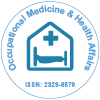Telemedicine & Remote Work Health: A New Era of Healthcare Delivery
Received: 01-Mar-2025 / Manuscript No. omha-25-170277 / Editor assigned: 03-Mar-2025 / PreQC No. omha-25-170277 / Reviewed: 17-Mar-2025 / QC No. omha-25-170277 / Revised: 22-Mar-2025 / Manuscript No. omha-25-170277 / Published Date: 29-Mar-2025
Introduction
The digital age has revolutionized many aspects of modern life, including how we access healthcare and how we work. Telemedicine—the remote diagnosis and treatment of patients through telecommunications technology—has rapidly gained prominence, especially in the wake of the COVID-19 pandemic. At the same time, remote work has become a widespread norm, transforming how employees manage their health and well-being [1],[2]. Together, these two developments are reshaping healthcare delivery, offering both new opportunities and challenges in managing health in a digital, decentralized world [3],[4].
Discussion
Telemedicine allows patients to consult doctors via video calls, apps, or phone, eliminating the need for physical visits for many routine or non-emergency consultations. It provides timely access to medical advice, especially for people living in remote areas, those with mobility challenges, or individuals with busy work schedules. In remote work environments, telemedicine acts as a lifeline, offering employees a convenient way to address health issues without interrupting their workflow or commuting to clinics [5],[6].
One of the most significant benefits of telemedicine is convenience. Remote workers can schedule virtual doctor visits during breaks, manage chronic conditions through digital monitoring tools, and even receive mental health counseling online. This flexibility helps maintain productivity while encouraging individuals to seek medical help early, potentially preventing more serious issues [7],[8].
Additionally, telemedicine supports preventive healthcare in remote work settings. With increased screen time, sedentary behavior, and blurred work-life boundaries, remote employees face risks such as eye strain, musculoskeletal problems, stress, and burnout. Telehealth services can offer ergonomic assessments, mental wellness sessions, and routine check-ups, fostering a culture of health awareness and self-care [9],[10].
Employers also play a role in promoting remote health services. Many now provide digital health benefits like online consultations, wellness apps, and virtual fitness programs. This not only supports employee well-being but also boosts morale and retention, showing that the organization values health and flexibility.
However, telemedicine is not without its challenges. The absence of physical examination limits the scope of diagnosis in certain cases. Some patients may lack access to stable internet, smartphones, or private spaces for consultations. There's also a need to address concerns about data security, privacy, and the quality of care delivered remotely.
Furthermore, remote work can sometimes lead to isolation and reduced physical activity, which might go unnoticed without regular health monitoring. Employers and healthcare providers must work together to create a support system that combines digital convenience with proactive health engagement.
Conclusion
Telemedicine and remote work health management are not just temporary trends—they represent a fundamental shift in how healthcare is accessed and delivered. By embracing telehealth, remote workers can receive timely, convenient care while maintaining productivity and work-life balance. However, to make this model truly effective, it is essential to address technological, social, and policy challenges. With the right infrastructure, education, and collaboration between employers and healthcare providers, telemedicine can become a powerful tool for sustaining the health and well-being of a growing remote workforce in the years to come.
References
- Einarsen S, Hoel H, Notelaers G (2009) Measuring exposure to bullying and harassment at work: validity, factor structure and psychometric properties of the negative acts questionnaire-revised. Work Stress23:24-44.
- Nielsen M, Hetland J, Matthiesen S, Einarsen S (2012) Longitudinal relationships between workplace bullying and psychological distress. Scand J Work Environ Health38:38-46.
- De Cuyper N, Baillien E, De Witte H (2009) Job insecurity, perceived employability and targets’ and perpetrators’ experiences of workplace bullying. Work Stress 23:206-224.
- Reknes I, Einarsen S, Knardahl S, Lau B (2014) The prospective relationship between role stressors and new cases of self-reported workplace bullying. Scand J Psychol 55:45-52.
- Greenberg J (2006) Losing sleep over organizational injustice: attenuating insomniac reactions to underpayment inequity with supervisory training in interactional justice. J Appl Psychol 91:58-69.
- Karasek RA (1979) Job demands, job decision latitude, and mental strain - implications for job redesign. Adm Sci Q24:285-308.
- Nielsen M, Einarsen S (2012) Outcomes of exposure to workplace bullying: a meta-analytic review. Work Stress 26:1-24.
- Tsutsumi A, Kawakami N (2004) A review of empirical studies on the model of effort–reward imbalance at work: reducing occupational stress by implementing a new theory. Soc Sci Med 59:2335-2359.
- Colquitt JA (2001) On the dimensionality of organizational justice: a construct validation of a measure. Appl Psychol 86:386-400.
- Salin D (2003) Ways of explaining workplace bullying: a review of enabling, motivating and precipitating structures and processes in the work environment. Hum Relat 56:1213-1232.
Citation: Ayesha R (2025) Telemedicine & Remote Work Health: A New Era of Healthcare Delivery. Occup Med Health 13: 568.
Copyright: © 2025 Ayesha R. This is an open-access article distributed under the terms of the Creative Commons Attribution License, which permits unrestricted use, distribution, and reproduction in any medium, provided the original author and source are credited.
Select your language of interest to view the total content in your interested language
Share This Article
Recommended Journals
Open Access Journals
Article Usage
- Total views: 258
- [From(publication date): 0-0 - Dec 10, 2025]
- Breakdown by view type
- HTML page views: 201
- PDF downloads: 57
